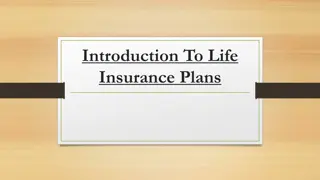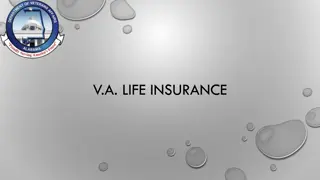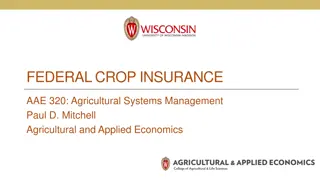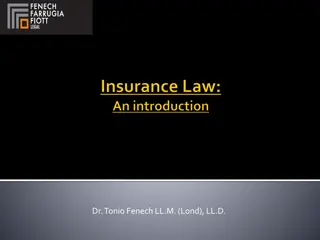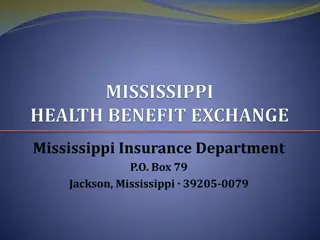The Functions of Insurance in Business Organizations
Various important functions are involved in the insurance business, including underwriting, production, rate making, loss adjustment, inspection, engineering, and marketing. Underwriting plays a crucial role in selecting and classifying potential policy owners to manage risks effectively. Factors such as mortality, property condition, and information disclosure impact the underwriting process. Key sources of information for underwriting include the applicant, agent, and insurer's own inspection and engineering department.
Download Presentation

Please find below an Image/Link to download the presentation.
The content on the website is provided AS IS for your information and personal use only. It may not be sold, licensed, or shared on other websites without obtaining consent from the author.If you encounter any issues during the download, it is possible that the publisher has removed the file from their server.
You are allowed to download the files provided on this website for personal or commercial use, subject to the condition that they are used lawfully. All files are the property of their respective owners.
The content on the website is provided AS IS for your information and personal use only. It may not be sold, licensed, or shared on other websites without obtaining consent from the author.
E N D
Presentation Transcript
Unit- 5 FUNCTIONS OF INSURANCE
5.1 Introduction A number of business functions are performed in writing and servicing insurance. Many of these functions are limited to insurance business; some are also applicable in other business organizations. However, several functions have special significance to the insurance business, and the performance of these functions can materially affect the character of the coverage provided by the insurer. With in the insurance business, these functions differ one from another according to their financial adequacy and lines of insurance but all insurance companies have the following common functions; 1. Underwriting 2. Production 3. Rate making (Premium Determination) 4. LossAdjustment, or Claim Management 5. Inspection, Engineering, and Loss Prevention 6. Marketing
5.2 Underwriting Underwriting is the process of selecting and classifying prospective policy owners or potential applicants. It involves assessing or evaluating the risks of the insured before accepting the proposal. Underwriting process determine, which applicants are eligible for insurance coverage. Based on this analysis, the insurer rejects some applicants and accepts others. The purpose of underwriting is to control adverse selection and assemble a group of insured s who loss potential is homogeneous. When loss potential is homogenous, the same insurance premium can be charged across insured s.
(Cont) Factors Considered in Insurance Underwriting Different factors need to be considered before accepting the proposal of the insured. For example, life insurance covers are aimed at protecting the dependents of the insured from suffering financial loss in the case of his premature death. This means the insurance gives protection for the risk of death. Therefore, in life insurance underwriting, the factors examined are those that influence mortality. These include age, sex, current physical condition, personal medical history, family medical history, occupation, habits, marital status and so on. These and other factors may affect the decision of the insured to accept or reject or to give protection or postpone the policy. The same is in the case of property insurance the condition of the property, nature, location, the value of the property and so on. These and other factors/ conditions may affect the type of the policy, its prices and provisions. The insured should disclose all material facts pertaining to the subject matter that is going to be insured. Otherwise, it may lead later to disputes or expensive litigation and may be grounds for the insurer to deny claims.
(Cont) Sources of Information for Underwriting The assessment and evolution of the risk is based on the information collected by the underwriter. The following are important sources of information for underwriting. 1. The applicant; insurance contract is a contract of utmost good faith. That means both parties to the contract should disclose all relevant information to make the contract valid. In this case the insured can give the appropriate information through the application form. The insurer can learn a lot about the insured from this and other documents such as medical report. 2. The Agent; agents of the insurer are also important sources of underwriting information. They know the sources of income, health condition, and other necessary information about a certain group of society in which they are appointed. 3. The Insurer s own Inspection and Engineering Department. 4. Companies, Bureaus and Associations. 5. Other Agencies; Therefore, on the basis of the information collected from these sources, the underwriters assesses and evaluate the risk and accordingly make a decision to accept or reject the proposal made by the insured against a particular risk.
5.3 Rate Making The establishment of a price for insurance is a complex activity and involves the incorporation of mathematical analysis in to competitive business decisions. Insurance cost is an important factor in the selection of an insurer. In order to evaluate properly the cost of the protection provided by a particular insurer, the risk manager must understand the principles and procedures of insurance pricing so that he/she can select/obtain the lowest possible price for his/her firm. From insurers view point, correct pricing of insurance is the foundation of financial security and solvency. Important problems emerge if the premium does not accurately reflect the risk being insured. If the price is too low, the insurer will not accumulate sufficient resources to cover claims and provide claim related services. If the price is too high, competitors will draw away customers. Insurance is a product for which the costs of goods sold is not known until some future date. As a result insurance companies must apply special techniques and methods for product pricing. The term insurance rate and insurance premium often are used interchangeably in ordinary conversation though they have distinct meanings in the insurance business. An insurance premium is the total coverage. Most insurance prices rely on claims data, the amount of insurance premium receipts, insurance claim costs, and costs of insurance related services. Its objective should be to charge faire and affordable price. It should not discriminate insured's and should be made based on business conditions.
5.4 Production Production involves in producing and selling insurance policies through agents, field workers and special agents. 5.5 Claim Settlement/ Loss Adjustment An insurance policy claim is a demand made by the insured or any party concerned for the payment of the policy money. The fundamental role of insurance claim is compensation of financial loss sustained by the insured in the event of the occurrence of an insured peril. In effecting claim settlement the insurers provide financial compensation in an attempt to restore the insured to his /her former position as he enjoyed immediately before the accident. Therefore, which ever an insured sustains an accident, which is likely to lead to a claim under a policy he is entitled to full and speedy settlement with the terms of the policy as long as the complies with duties(implies and expressed) imposed up on him.
(Cont) To this effect the insured is duty bound to act as if he was uninsured and take all reasonable steps to minimize his loss. These duties are known as implied duties. Expressed duties include immediate notification of any event and to provide particulars within the specified period. The notification can be verbal or in writing. Most policies give insurers the option to settle claims either in cash, reinstate or repair the damaged property. Loss adjustment is an activity that is taken by a claim department. It involves verification of the loss, fair and prompt payment and personal assistance to the insured who faces an accident. Every insurance company has this department or division.
(Cont) Steps in settlement of claims Step-1 ; Notification The insured is required to give an immediate notification of the event occurred which leads to the initiation of claims in the manner specified in the policy. Notification can be made orally or in writing. Step-2; Investigation The claim adjuster (a person in the claim department) should investigate the amount and the causes of the loss before indemnification is made. The claim adjuster should raise and answer the following questions. Did the loss actually occur while the policy is enforce? Does the policy covers the peril that causes the loss? Does the policy cover property destroyed in the loss? Is the claim fraudulent or real/actual? And so on. Step- 3; AProof of Loss must be filed by the insured. Step- 4; At last Decision (Accept/Reject) Concerning the Payment will be made. Faster and more exact claim settlement will be made when the insured provide complete well- organized data that support a claim.
5.6 Marketing In this competitive environment if a business wants to stay in the market, it should provide or deliver quality product at a fair price and all this should be informed to the public so that they can be attracted toward the company and its offering. All these are the activity of marketing. Marketing is a function common in service or manufacturing; small or large organization. It is the process of planning the development of a product, pricing, promotion and distributing the product and creating an exchange, therefore, this function is also important success factor in insurance business.
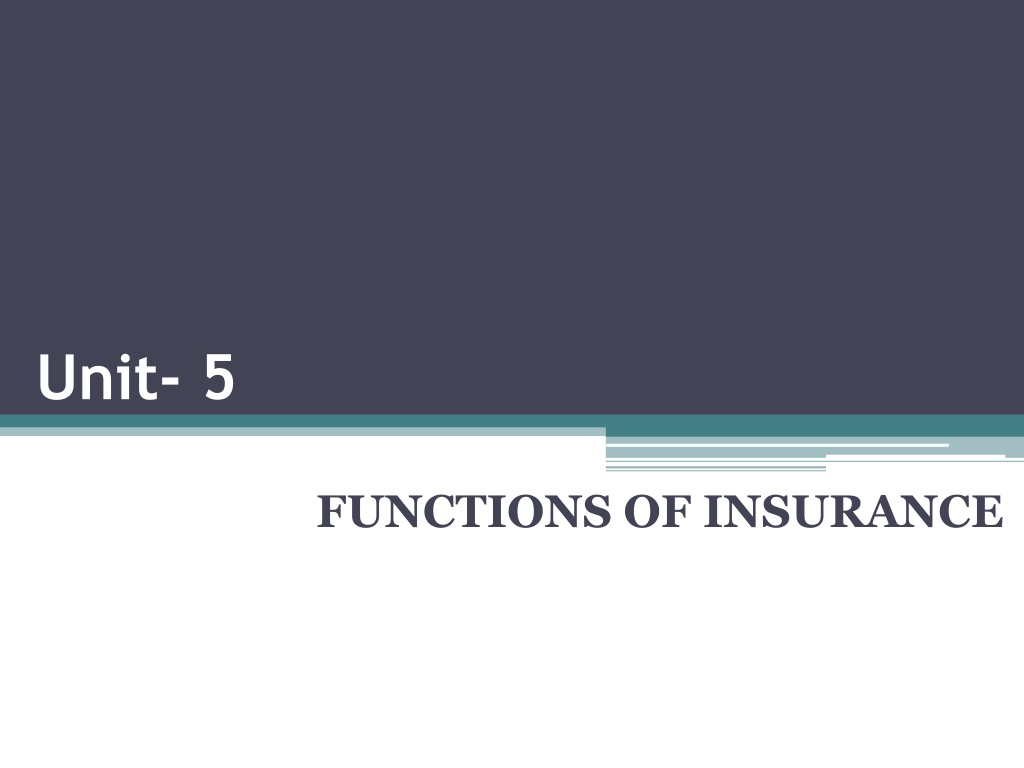
 undefined
undefined













